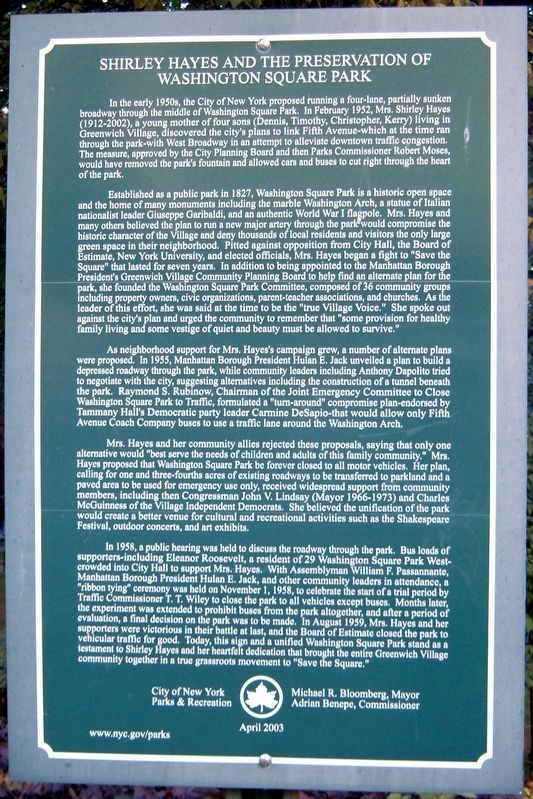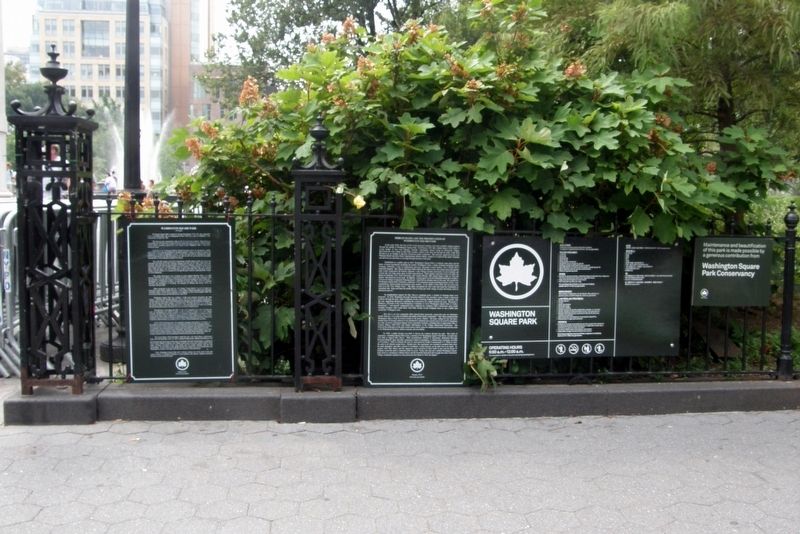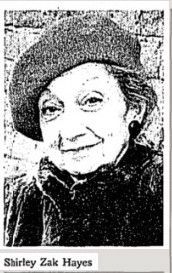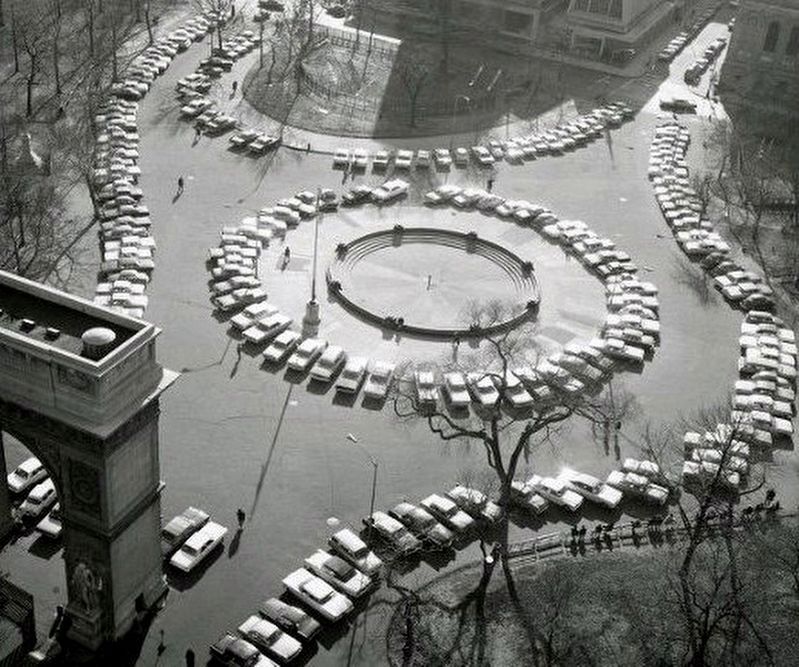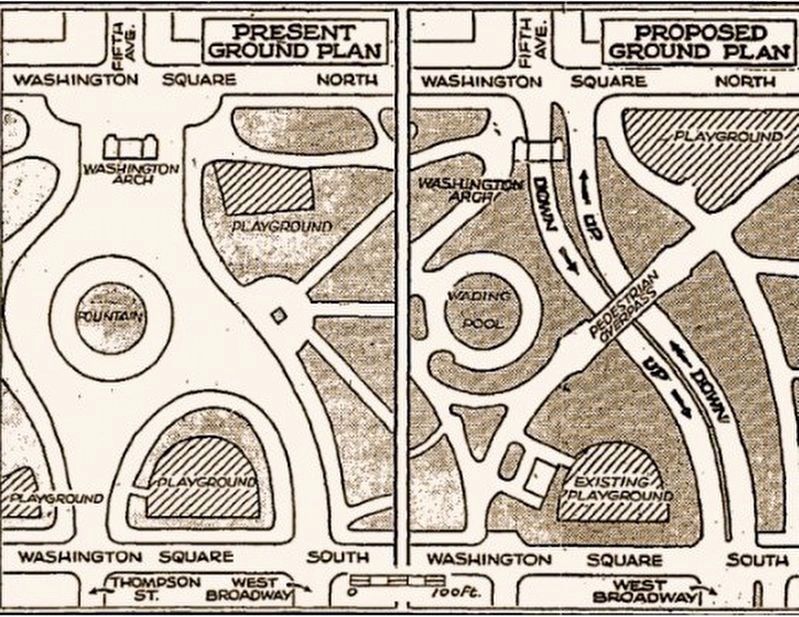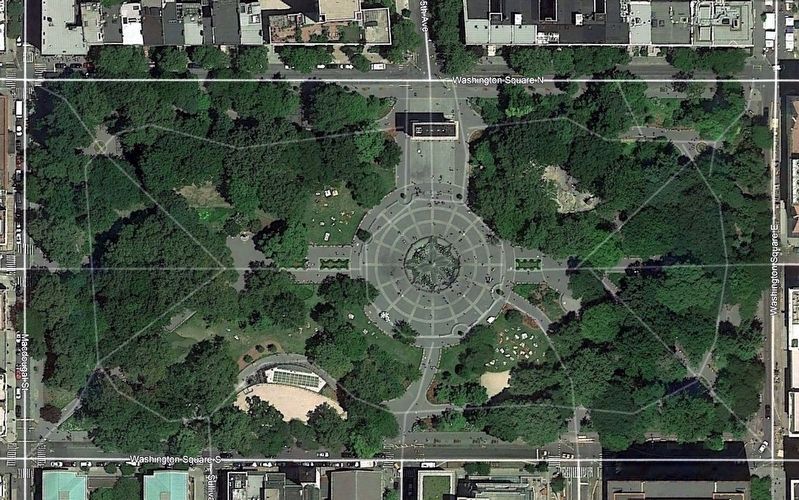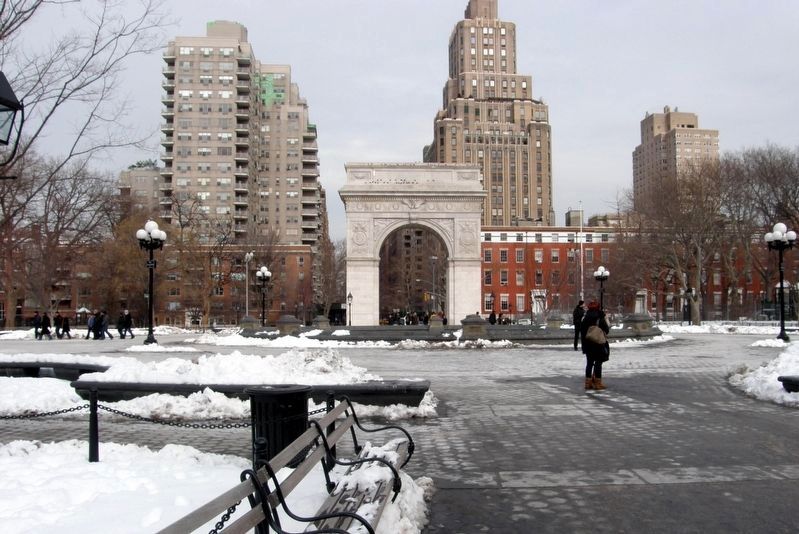Greenwich Village in Manhattan in New York County, New York — The American Northeast (Mid-Atlantic)
Shirley Hayes and the Preservation of Washington Square Park
Inscription.
In the early 1950s , the City of New York proposed running a four-lane, partially sunken broadway through the middle of Washington Square Park. In February 1952, Mrs. Shirley Hayes (1912-2002), a young mother of four sons (Dennis, Timothy, Christopher, Kerry) living in Greenwich Village, discovered the city’s plans to link Fifth Avenue – which at the time ran through the park – with West Broadway in an attempt to alleviate downtown traffic congestion. The measure, approved by the City Planning Board and then Parks Commissioner Robert Moses, would have removed the park’s fountain and allowed cars and buses to cut right through the heart of the park.
Established as a public park in 1827, Washington Square Park is a historic open space and the home of many monuments including the marble Washington Arch, a statue of Italian nationalist leader Giuseppe Garibaldi, and an authentic World War I flagpole. Mrs. Hayes and many others believed the plan to run a new major artery through the park would compromise the historic character, of the Village and deny thousands of local residents and visitors the only large green space in their neighborhood. Pitted against opposition from City Hall, the Board of Estimate, New York University, and elected officials, Mrs. Hayes began a fight to “Save the Square” that lasted for seven years. In addition to being appointed to the Manhattan Borough President’s Greenwich Village Community Planning Board to help find an alternate plan for the park, she founded the Washington Square Park Committee, composed of 36 community groups, including property owners, civic associations, parent-teacher associations, and churches. As the leader of this effort, she was said at the time to be the “true Village Voice.” She spoke out against the city’s plan and urged the community to remember that “some provision for healthy family living and some vestige of quiet and beauty must be allowed to survive.”
As neighborhood support for Mrs. Hayes’s campaign grew, a number of alternate plans were proposed. In 1955, Manhattan Borough President Hulan E. Jack unveiled a plan to build a depressed roadway through the park, while community leaders including Anthony Dapilito tried to negotiate with the city, suggesting alternatives including a tunnel beneath the park. Raymond S. Rubinow, Chairman of the Joint Emergency Committee to Close Washington Square Park to Traffic, formulated a “turn-around” compromise that would allow only Fifth Avenue Coach Company buses to use a traffic lane around the Washington Arch.
Mrs. Hayes and her community allies rejected these proposals, saying that only one alternative would “best serve the
needs of children and adults of the family community.” Mrs. Hayes proposed that Washington Square Park be forever closed to all motor vehicles. Her plan, calling for one and three-fourths acres of existing roadways be transferred to parkland and a paved area to be used for emergency use only, received widespread support from community members, including then Congressman John V. Lindsay (Mayor 1966-1973) and Charles McGuiness of the Village Independent Democrats. She believed the unification of the park would create a better venue for cultural and recreational activities such as the Shakespeare Festival, outdoor concerts, and art exhibits.
In 1958, a public hearing was held to discuss a roadway through the park. Bus loads of supporters – including Eleanor Roosevelt – a resident of 20 Washington Square Park West – crowded into City Hall to support Mrs. Hayes. With Assemblyman William F. Passannante, Manhattan Borough President Hulan E. Jack, and other community leaders in attendance, a “ribbon-tying” ceremony was held on November 1, 1958, to celebrate the start of a trial period by Traffic Commissioner T.T. Wiley to close the park to all vehicles except buses. Months later, the experiment was extended to prohibit buses from the park altogether, and after a period of evaluation, a final decision on the park was to be made. In August 1959, Mrs. Hayes and her supporters were victorious in their battle at last, and the Board of Estimate closed the park to vehicular traffic for good. Today, this sign and a unified Washington Square Park stand as a testament to Shirley Hayes and her heartfelt dedication that brought the entire Greenwich Village community in a true grassroots movement to “Save the Square.”
City of New York Parks and Recreation
Michael R. Bloomberg, Mayor
Adrian Benepe, Commissioner
April 2003
Erected 2003 by City of New York Parks and Recreation.
Topics and series. This historical marker is listed in these topic lists: Government & Politics • Parks & Recreational Areas • Roads & Vehicles • Women. In addition, it is included in the Eleanor Roosevelt series list. A significant historical month for this entry is February 1952.
Location. 40° 43.886′ N, 73° 59.833′ W. Marker is in Manhattan, New York, in New York County. It is in Greenwich Village. Marker is on Washington Square North near Fifth Avenue, on the left when traveling west. Touch for map. Marker is at or near this postal address: Washington Square Park, New York NY 10012, United States of America. Touch for directions.
Other nearby markers. At least 8 other markers are within walking distance of this marker. Washington Square Park (here, next to this marker); Washington Arch (a few steps from this marker); Washington Square WWI Memorial (within shouting distance of this marker); Bella Abzug (within shouting distance of this marker); Edward I. Koch (within shouting distance of this marker); Alexander Lyman Holley (about 300 feet away, measured in a direct line); NYU 9/11 Memorial (about 300 feet away); No. 22 Washington Square North (about 300 feet away). Touch for a list and map of all markers in Manhattan.
Regarding Shirley Hayes and the Preservation of Washington Square Park. The 1950s plan for a Washington Square Highway
From Ephemeral New York: "Another half-baked idea that (luckily) never got off the ground was a plan for a highway running through Washington Square Park, proposed many times through the 1950s by “master builder” Robert Moses."
Link at https://ephemeralnewyork.wordpress.com/2014/04/12/the-1950s-plan-for-a-washington-square-highway/
Also see . . . Shirley Hayes. New York Times obituary (Submitted on September 5, 2019, by Larry Gertner of New York, New York.)
Credits. This page was last revised on January 31, 2023. It was originally submitted on September 5, 2019, by Larry Gertner of New York, New York. This page has been viewed 321 times since then and 37 times this year. Photos: 1, 2, 3, 4, 5, 6. submitted on September 5, 2019, by Larry Gertner of New York, New York. 7. submitted on September 7, 2019, by Larry Gertner of New York, New York. • Andrew Ruppenstein was the editor who published this page.
